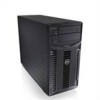Dell PowerEdge T410 Hardware Owner's Manual - Page 71
Embedded Server Management Screen (Optional), Power Management Screen, User Defined String - second cpu
 |
View all Dell PowerEdge T410 manuals
Add to My Manuals
Save this manual to your list of manuals |
Page 71 highlights
Embedded Server Management Screen (Optional) Option Description Front-Panel LCD Options Options are User Defined String, Model Number, and None. If the LCD Home screen is set to an option other than these three choices, the option will be displayed as "Advanced" in the BIOS. In this event, the option cannot be changed in the BIOS unless it is changed back to User Defined String, Model Number, or None through another LCD configuration utility (such as the BMC or iDRAC Configuration Utility or the LCD panel menu). User-Defined LCD String You can enter a name or another identifier for the system, to be displayed on the LCD module screen. Power Management Screen Option Power Management Description Options are OS Control, Active Power Controller, Custom, or Maximum Performance. For all but the Custom setting, the BIOS pre-configures the power settings on this screen as follows: • OS Control sets the CPU power to OS DBPM, the fan power to Minimum Power, and the memory power to Maximum Performance. In this setting, all processor performance information is passed from the system BIOS to the operating system for control. The operating system sets the processor performance based on processor utilization. • Active Power Controller sets the CPU power to System DBPM, the fan power to Minimum Power, and the memory power to Maximum Performance. The BIOS sets the processor performance based on processor utilization. • Maximum Performance sets all fields to Maximum Performance. Using the System Setup Program and UEFI Boot Manager 71















